VISIT TO DOWN AMPNEY HOUSE
12th of July, 2025
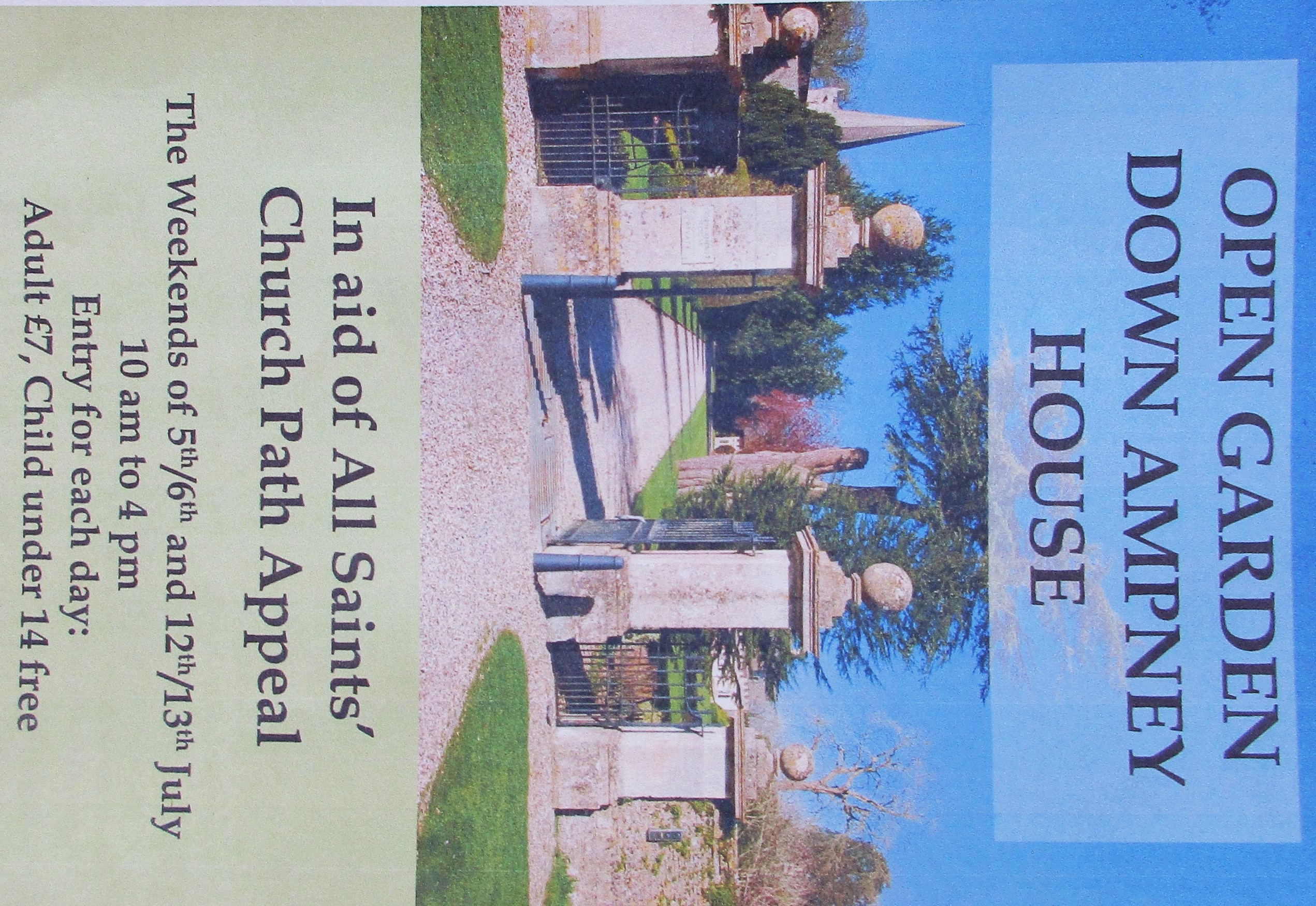 When we first arrived in the Cotswolds in 2021 I had noted that Down Ampney was one of the fairly local villages, and I knew that that had been the birthplace of Ralph Vaughan Williams. It was under his direction that, as a late schoolboy, I had taken part in choral performances of his Sea Symphony and of Bach's St Matthew Passion. I duly visited the village, in May 2023, and confirmed that that origin was generously commemorated, in the church and elsewhere. The visit was recorded as My 2023 exploration of Down Ampney.
When we first arrived in the Cotswolds in 2021 I had noted that Down Ampney was one of the fairly local villages, and I knew that that had been the birthplace of Ralph Vaughan Williams. It was under his direction that, as a late schoolboy, I had taken part in choral performances of his Sea Symphony and of Bach's St Matthew Passion. I duly visited the village, in May 2023, and confirmed that that origin was generously commemorated, in the church and elsewhere. The visit was recorded as My 2023 exploration of Down Ampney.
Free advertising periodicals abound in Cirencester, commonly ignored but sometimes providing useful leads. Noting that Down Ampney House garden was to be open to the public in what turned out to be a summer heatwave I resolved to put my ebike to use again, July the 12th being most convenient (eight days ahead of my ninety-third birthday). So there was no virgin territory for me in pedalling the eight miles or so to the far side of South Cerney, past lakes to Cerney Wick and bridging the A419 dual carriageway to access the Down Ampney road. Thence first right to the church and House, with a good shady spot to padlock my bike in the field car park.
 The main entrance and driveway led directly to the main house, of course. But that was not the object of exploration on this occasion. That the lawns still bore any tinge of green was miraculous during the weeks-long drought and scorching temperatures.
The main entrance and driveway led directly to the main house, of course. But that was not the object of exploration on this occasion. That the lawns still bore any tinge of green was miraculous during the weeks-long drought and scorching temperatures.
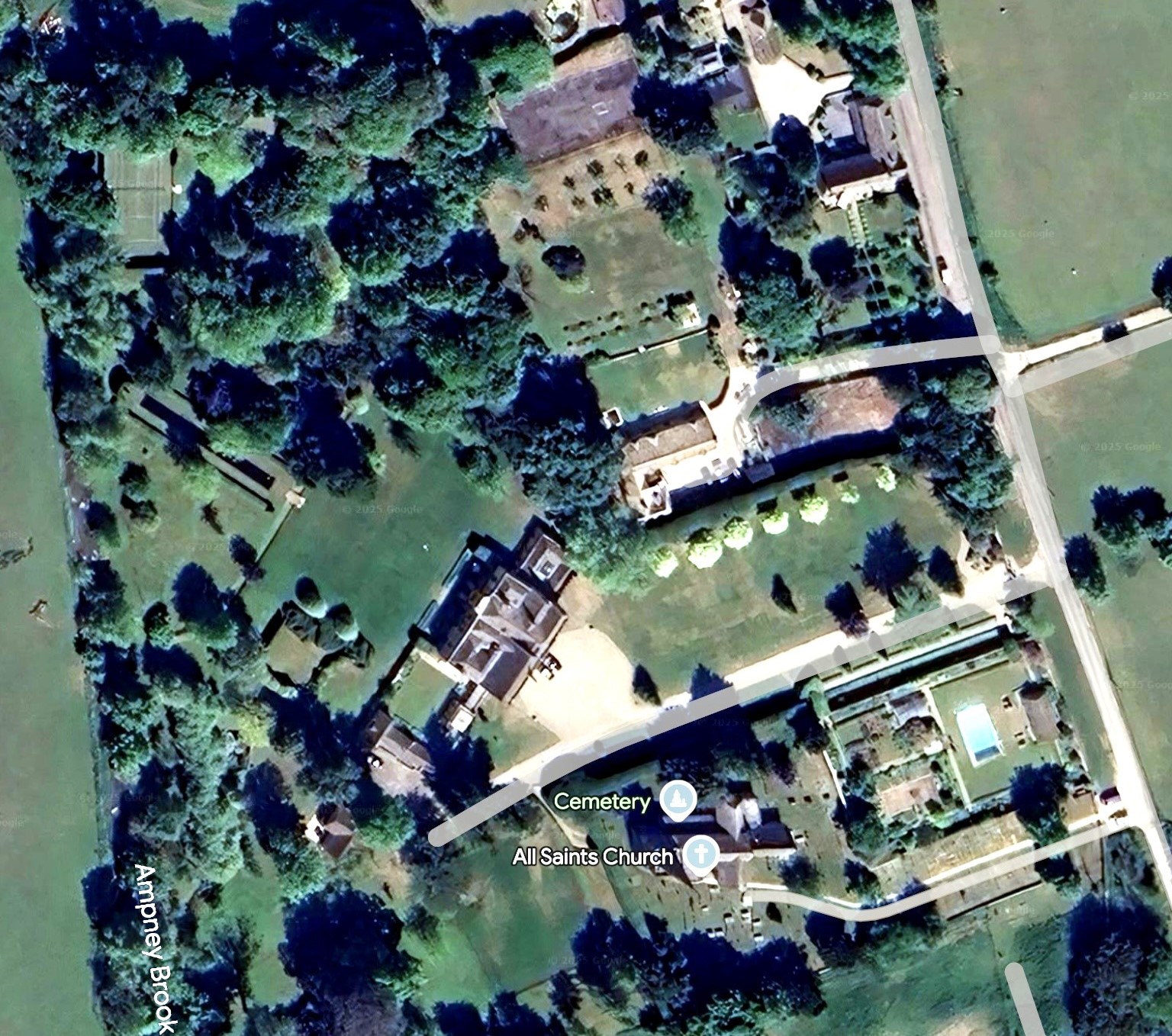 The advertised 'gardens' might well have been designated 'grounds'. Our invitation covered much of the area between the roadway and the Ampney Brook which marks the Glos/Wilts border, almost surrounding the All Saints Church and Cemetery too. The tree cover is as much of splendid individuals and groups as of beechwood forest - as we'll see. Water features vary in colour, size and purpose, while floral perennials and climbers ornament hidden borders, courtyards and buildings. Every open grass area is tended immaculately, including the croquet lawn, while Nature holds sway between the woodland paths.
The advertised 'gardens' might well have been designated 'grounds'. Our invitation covered much of the area between the roadway and the Ampney Brook which marks the Glos/Wilts border, almost surrounding the All Saints Church and Cemetery too. The tree cover is as much of splendid individuals and groups as of beechwood forest - as we'll see. Water features vary in colour, size and purpose, while floral perennials and climbers ornament hidden borders, courtyards and buildings. Every open grass area is tended immaculately, including the croquet lawn, while Nature holds sway between the woodland paths.
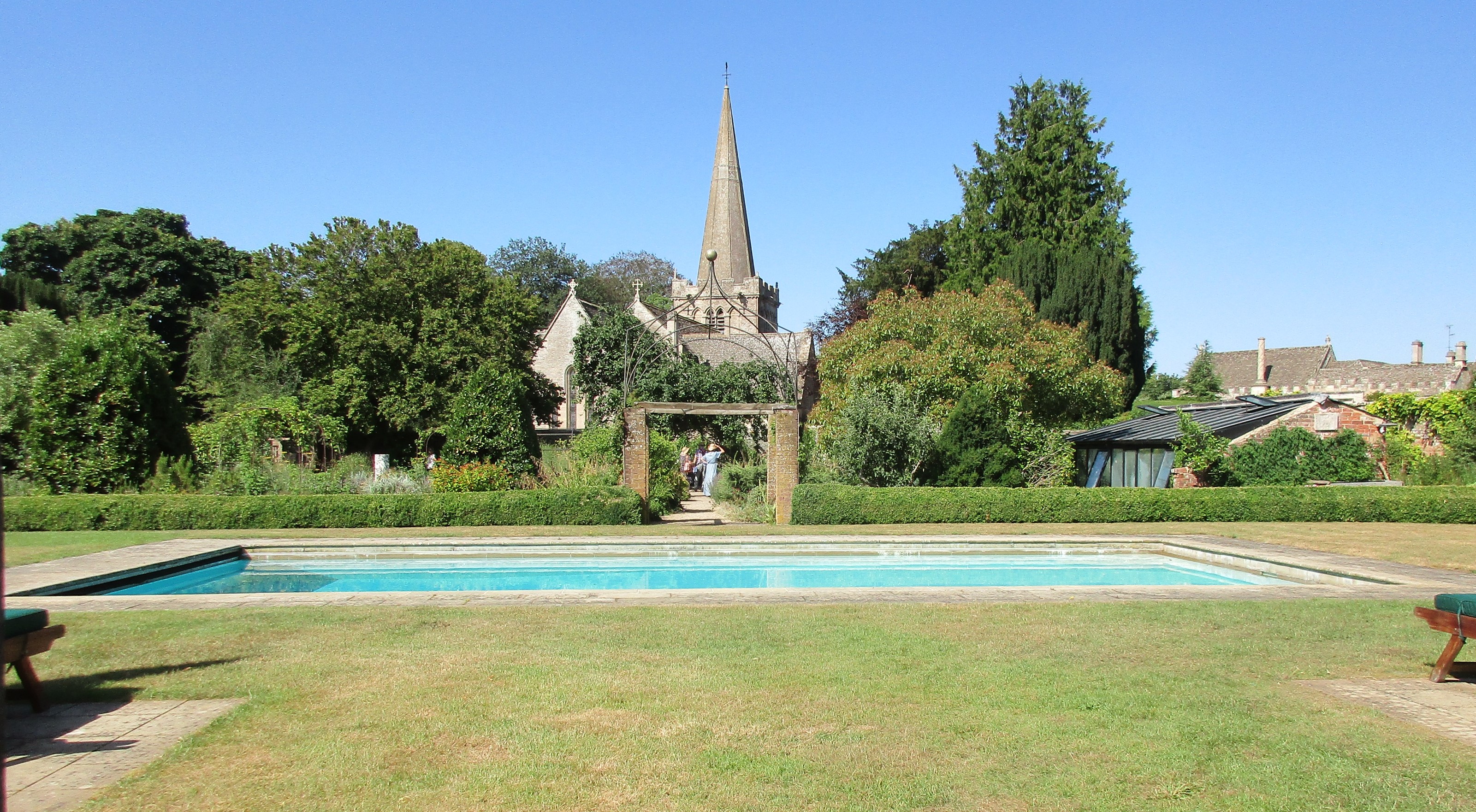 First feature on the suggested visitors' tour was the walled garden, backing onto the (invisible) road. Beyond the swimming pool, seen here looking out from the pool house, are traditional garden borders and trellises plus a hidden greenhouse. All Saints Church dominates beyond the boundary wall.
First feature on the suggested visitors' tour was the walled garden, backing onto the (invisible) road. Beyond the swimming pool, seen here looking out from the pool house, are traditional garden borders and trellises plus a hidden greenhouse. All Saints Church dominates beyond the boundary wall.
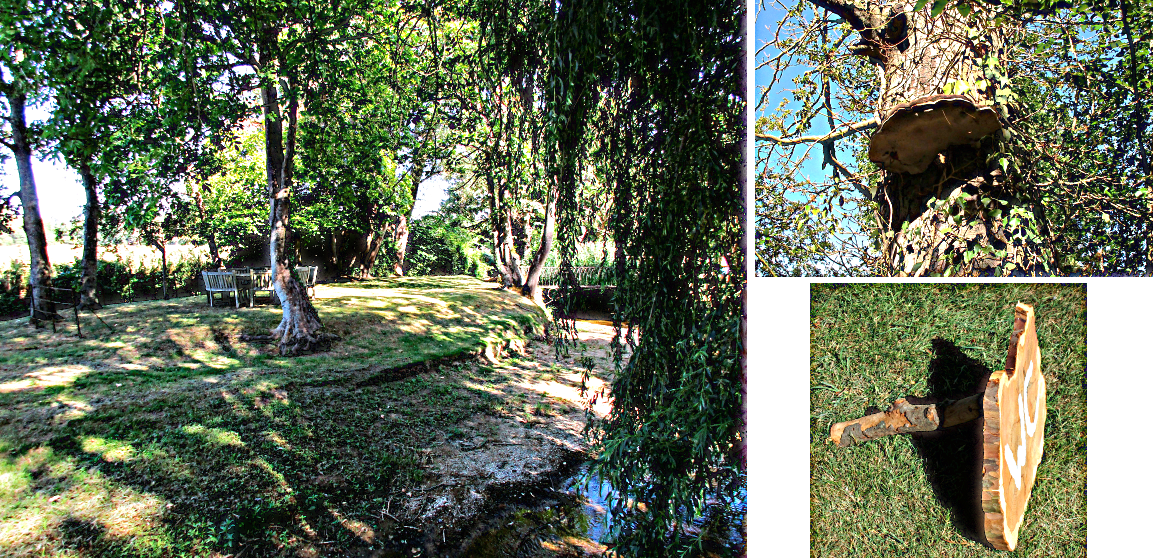 Beyond the croquet lawn lies ancient woodland, predominantly of mature beech and therefore with a limited under-storey, helpful for easy access. Naturally, fungi have been active, before or certainly after the death of a host, producing the largest bracket fungus I have ever seen. The woodland's western limit is the Ampney Brook, which may be followed northwards to the small island claimed neither by Gloucestershire nor Wiltshire. Happily, the woodland provided visitor guides!
Beyond the croquet lawn lies ancient woodland, predominantly of mature beech and therefore with a limited under-storey, helpful for easy access. Naturally, fungi have been active, before or certainly after the death of a host, producing the largest bracket fungus I have ever seen. The woodland's western limit is the Ampney Brook, which may be followed northwards to the small island claimed neither by Gloucestershire nor Wiltshire. Happily, the woodland provided visitor guides!
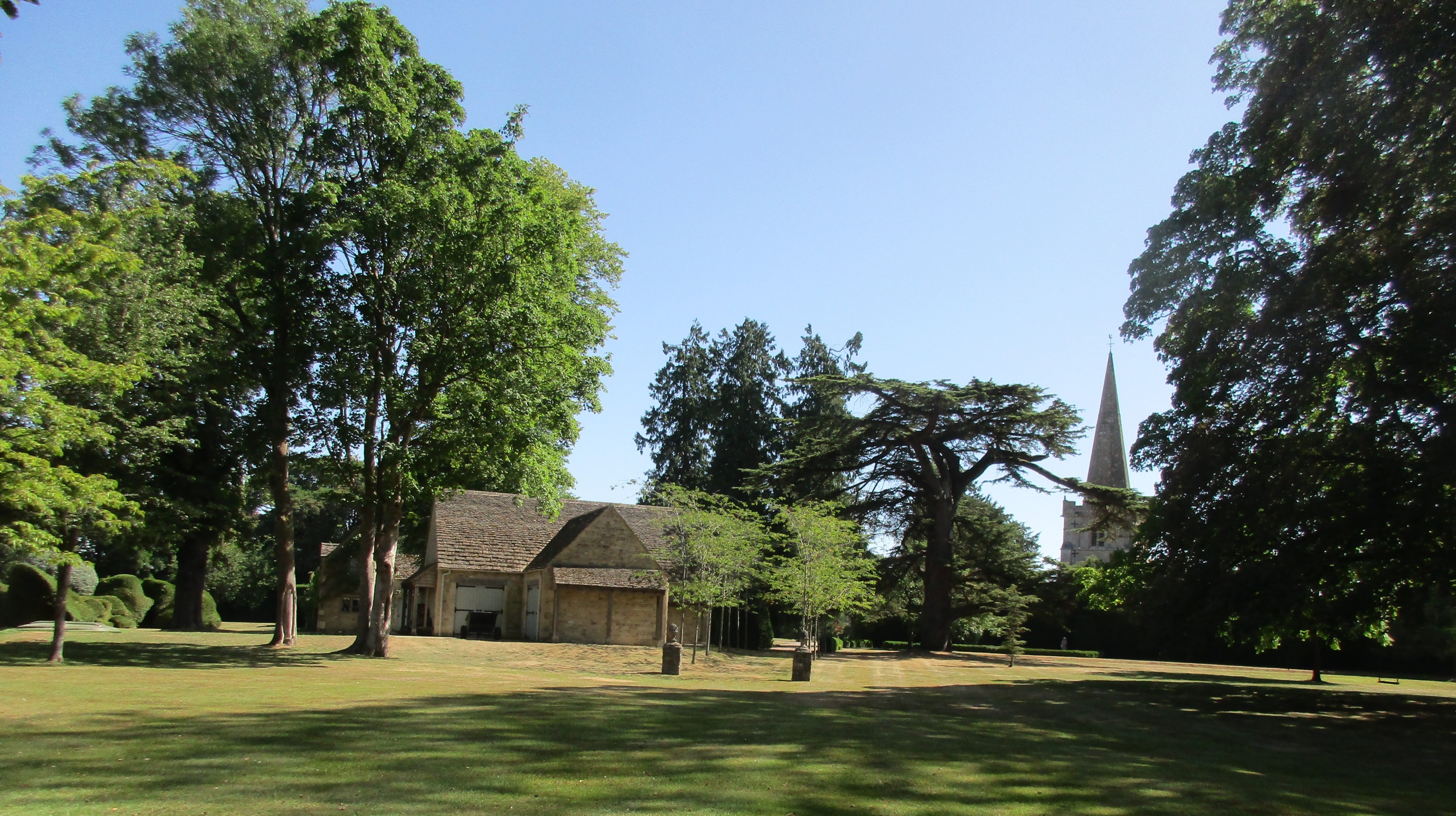 Typical of the wonderful treescapes is this view looking east from the Brook, towards the ancillary buildings and the church. Specimens vary widely in colour, shape, family and age - a never-ending project.
Typical of the wonderful treescapes is this view looking east from the Brook, towards the ancillary buildings and the church. Specimens vary widely in colour, shape, family and age - a never-ending project.
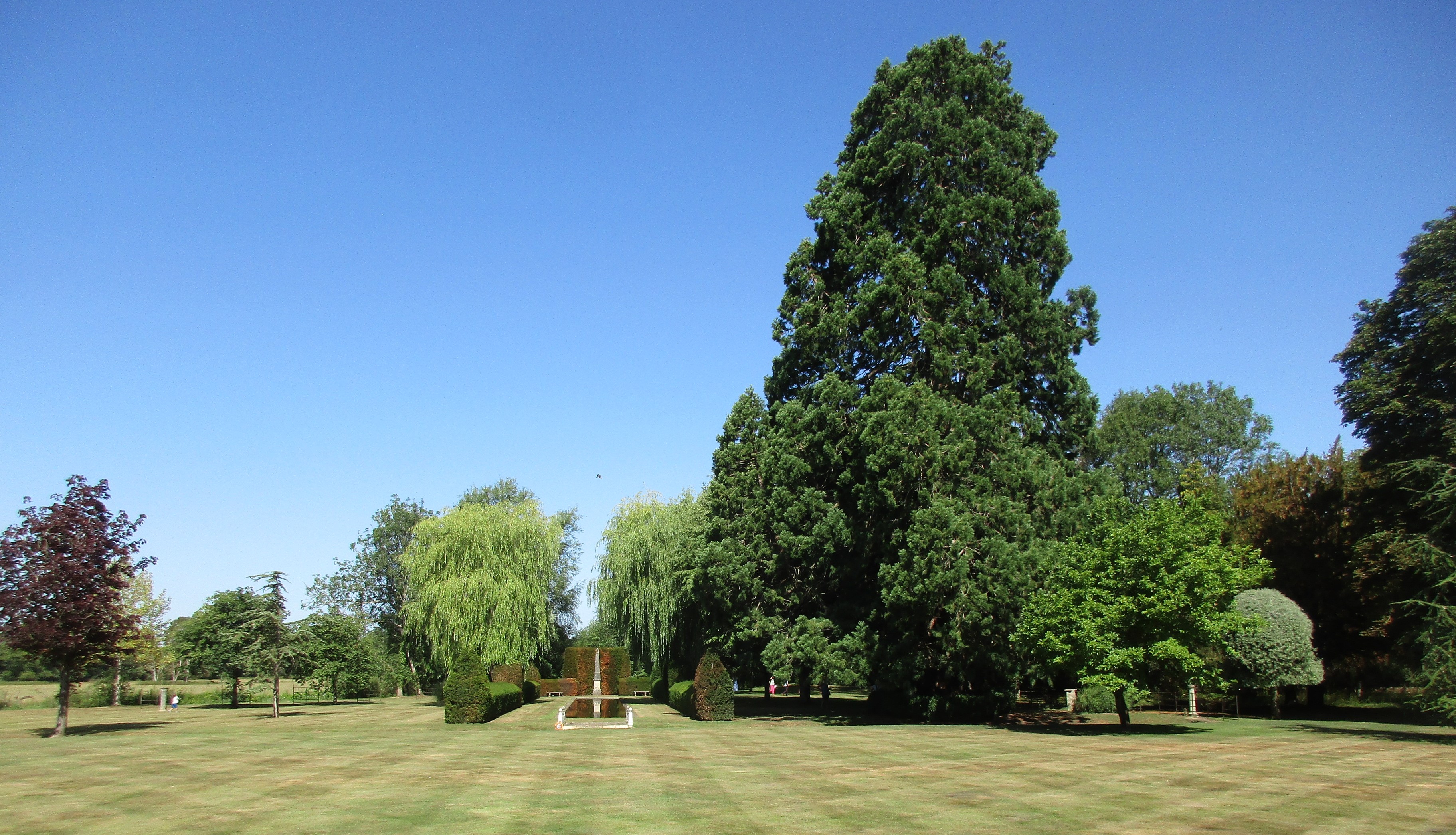 Perhaps pride of the estate is the massive, dominating 'Giant Redwood', 'Wellingtonia', Sequoiadendron giganteum, now well into its second century from its Victorian origin.
Perhaps pride of the estate is the massive, dominating 'Giant Redwood', 'Wellingtonia', Sequoiadendron giganteum, now well into its second century from its Victorian origin.
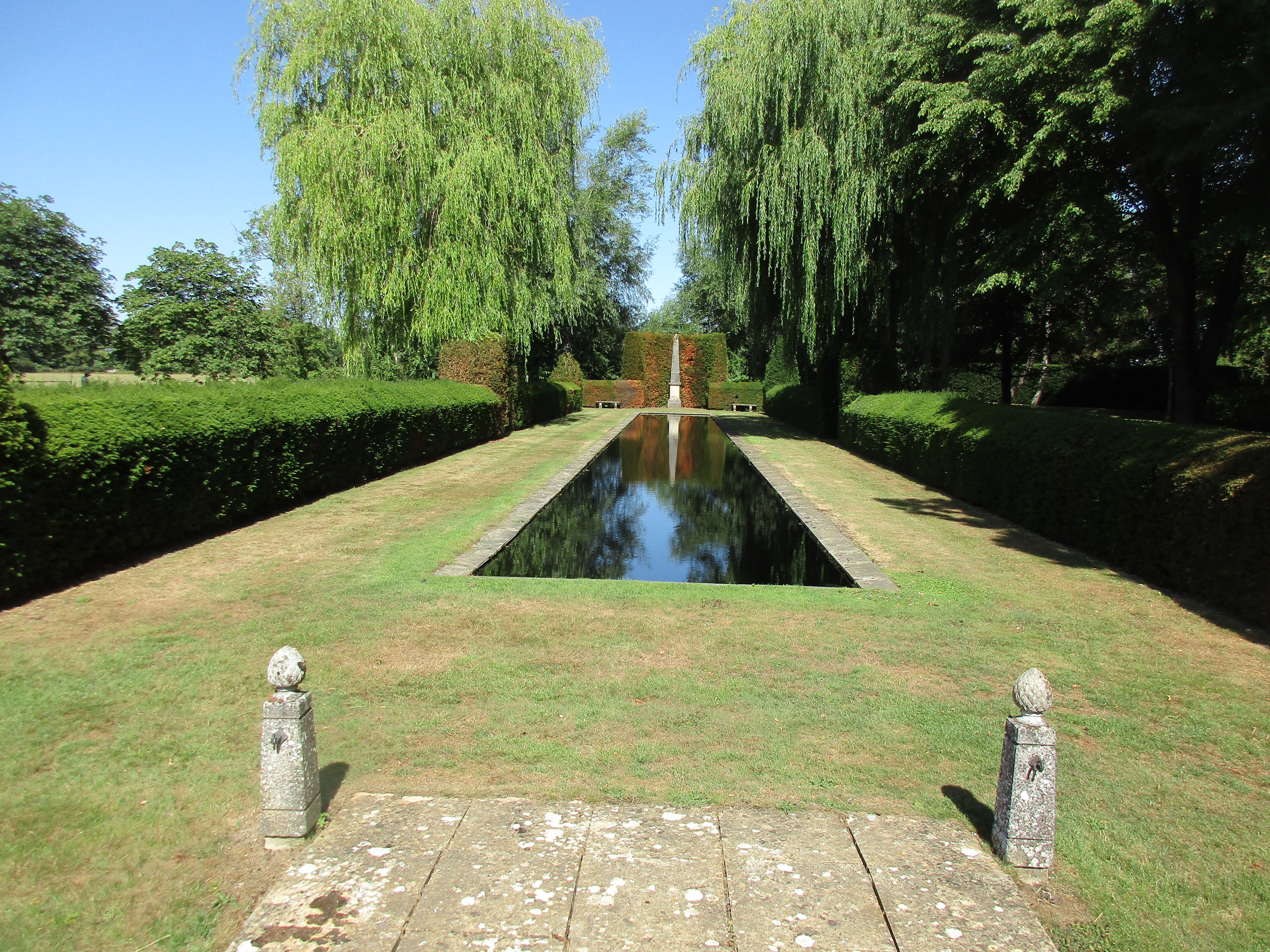 In closer view, the reflection pool provides a formal element, bordered by yew hedges.
In closer view, the reflection pool provides a formal element, bordered by yew hedges.
Many pages could have been filled with detailed images: this selection is just my initial choice of clicks during my first superficial exploration. Nor did I commission any portrait of my enjoying a coffee and ginger cake in the conservatory courtyard. I was anxious to complete my journey home before the heatwave temperatures made travel uncomfortable.
It was a surprise to learn that the owners, Charlotte and Keith, had been in possession only "since arriving at Down Ampney House last year" [2024, then] according to their guide notes. They and their staff have manifestly achieved much, and their notes indicate further future developments which "respect the past, but also embrace contemporary ideas". A long-term project indeed.
 When we first arrived in the Cotswolds in 2021 I had noted that Down Ampney was one of the fairly local villages, and I knew that that had been the birthplace of Ralph Vaughan Williams. It was under his direction that, as a late schoolboy, I had taken part in choral performances of his Sea Symphony and of Bach's St Matthew Passion. I duly visited the village, in May 2023, and confirmed that that origin was generously commemorated, in the church and elsewhere. The visit was recorded as My 2023 exploration of Down Ampney.
When we first arrived in the Cotswolds in 2021 I had noted that Down Ampney was one of the fairly local villages, and I knew that that had been the birthplace of Ralph Vaughan Williams. It was under his direction that, as a late schoolboy, I had taken part in choral performances of his Sea Symphony and of Bach's St Matthew Passion. I duly visited the village, in May 2023, and confirmed that that origin was generously commemorated, in the church and elsewhere. The visit was recorded as My 2023 exploration of Down Ampney. The main entrance and driveway led directly to the main house, of course. But that was not the object of exploration on this occasion. That the lawns still bore any tinge of green was miraculous during the weeks-long drought and scorching temperatures.
The main entrance and driveway led directly to the main house, of course. But that was not the object of exploration on this occasion. That the lawns still bore any tinge of green was miraculous during the weeks-long drought and scorching temperatures. The advertised 'gardens' might well have been designated 'grounds'. Our invitation covered much of the area between the roadway and the Ampney Brook which marks the Glos/Wilts border, almost surrounding the All Saints Church and Cemetery too. The tree cover is as much of splendid individuals and groups as of beechwood forest - as we'll see. Water features vary in colour, size and purpose, while floral perennials and climbers ornament hidden borders, courtyards and buildings. Every open grass area is tended immaculately, including the croquet lawn, while Nature holds sway between the woodland paths.
The advertised 'gardens' might well have been designated 'grounds'. Our invitation covered much of the area between the roadway and the Ampney Brook which marks the Glos/Wilts border, almost surrounding the All Saints Church and Cemetery too. The tree cover is as much of splendid individuals and groups as of beechwood forest - as we'll see. Water features vary in colour, size and purpose, while floral perennials and climbers ornament hidden borders, courtyards and buildings. Every open grass area is tended immaculately, including the croquet lawn, while Nature holds sway between the woodland paths. First feature on the suggested visitors' tour was the walled garden, backing onto the (invisible) road. Beyond the swimming pool, seen here looking out from the pool house, are traditional garden borders and trellises plus a hidden greenhouse. All Saints Church dominates beyond the boundary wall.
First feature on the suggested visitors' tour was the walled garden, backing onto the (invisible) road. Beyond the swimming pool, seen here looking out from the pool house, are traditional garden borders and trellises plus a hidden greenhouse. All Saints Church dominates beyond the boundary wall. Beyond the croquet lawn lies ancient woodland, predominantly of mature beech and therefore with a limited under-storey, helpful for easy access. Naturally, fungi have been active, before or certainly after the death of a host, producing the largest bracket fungus I have ever seen. The woodland's western limit is the Ampney Brook, which may be followed northwards to the small island claimed neither by Gloucestershire nor Wiltshire. Happily, the woodland provided visitor guides!
Beyond the croquet lawn lies ancient woodland, predominantly of mature beech and therefore with a limited under-storey, helpful for easy access. Naturally, fungi have been active, before or certainly after the death of a host, producing the largest bracket fungus I have ever seen. The woodland's western limit is the Ampney Brook, which may be followed northwards to the small island claimed neither by Gloucestershire nor Wiltshire. Happily, the woodland provided visitor guides! Typical of the wonderful treescapes is this view looking east from the Brook, towards the ancillary buildings and the church. Specimens vary widely in colour, shape, family and age - a never-ending project.
Typical of the wonderful treescapes is this view looking east from the Brook, towards the ancillary buildings and the church. Specimens vary widely in colour, shape, family and age - a never-ending project. Perhaps pride of the estate is the massive, dominating 'Giant Redwood', 'Wellingtonia', Sequoiadendron giganteum, now well into its second century from its Victorian origin.
Perhaps pride of the estate is the massive, dominating 'Giant Redwood', 'Wellingtonia', Sequoiadendron giganteum, now well into its second century from its Victorian origin. In closer view, the reflection pool provides a formal element, bordered by yew hedges.
In closer view, the reflection pool provides a formal element, bordered by yew hedges.